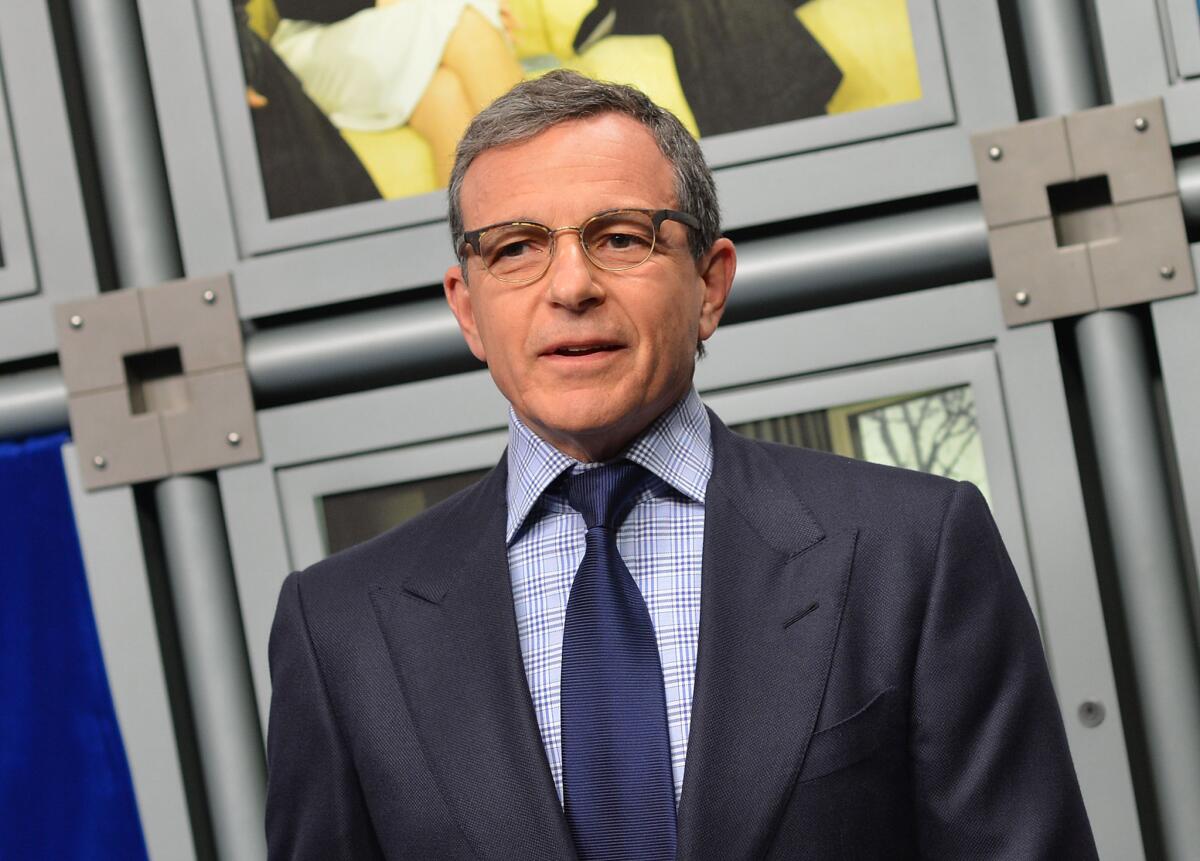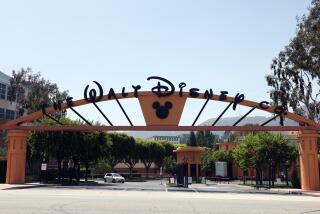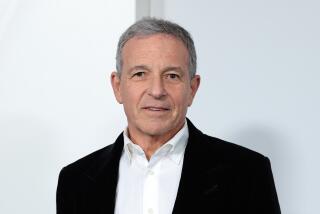How Disney’s Bob Iger went from underrated CEO to Hollywood royalty

Fifteen years ago, Bob Iger was typecast.
“A loyal drone,” recalled Jeffrey Sonnenfeld, an associate dean at the Yale School of Management.
Iger had scaled the ranks at ABC, but few thought he was up to the challenge of running the entire Walt Disney Co. Critics dismissed him as a former TV weatherman who lacked the spark and vision to follow his larger-than-life boss, Michael Eisner, not to mention the company’s founder, Walt Disney.
Then-directors Roy E. Disney and Stanley Gold, who led a shareholder revolt against Eisner, considered Iger — formerly Disney’s No. 2 executive — an Eisner loyalist, not to be trusted with the top job. “There are stronger candidates out there,” Gold told the Los Angeles Times in 2004.
Years earlier, even Eisner had offered tepid support of Iger, writing in a 1996 memo to directors: “He is not an enlightened or brilliantly creative man, but with a strong board he absolutely could do the job.” (Eisner later would champion Iger’s candidacy for CEO.)
“The expectations were so low for Bob,” Sonnenfeld said. “But no mogul in traditional entertainment has accomplished what he has.”
So how did Iger, who announced last week that he was stepping down as Disney’s chief executive, go from an underrated executive to one of America’s most successful corporate titans who transformed not only Disney but all of Hollywood?
The answer, according to those who worked with Iger over the years, lies in his discipline, his thoughtful and straightforward management style and a knack for forging trust with business partners — including former adversaries.
“He has charisma, and he is smarter than he thinks he is,” said Alan Horn, co-chairman of Walt Disney Studios, who joined the company in 2012. “And Bob possesses both courage and vision, which is rare. Few people have both.”
After the New York native took over Disney in 2005, he sought to reverse the damage from several tumultuous years (including an aborted takeover attempt by Comcast Corp.) and mend frayed relationships. He swiftly created allies in Roy Disney and Gold, recognizing the need to have the co-founder’s nephew in his corner to gain credibility with legions of Disney fans.
He worked to boost morale within the company by dismantling a management system that often pitted executives against one other. He gave more autonomy to division heads who had chafed under relentless meddling by Disney’s powerful strategic planning department.
Those overtures did more than soothe bruised egos. They proved to be the foundation of Iger’s success. His charm campaign extended to Steve Jobs, the Apple co-founder who propelled Pixar Animation Studios into a juggernaut with such hits as “Toy Story” and “Finding Nemo.”
At the time, Disney’s own studio seemed out of gas. Remember “The Country Bears”? In Palo Alto, Jobs was fuming over Disney’s plan to develop Pixar sequels on its own at a Glendale studio that some dubbed “Pixarent.”
In his 2019 memoir, “The Ride of a Lifetime,” Iger recalled Jobs’ reaction when Iger said he would be the next CEO. Jobs asked just one question: How long had he worked for Eisner?
“Ten years,” Iger said, drawing a lukewarm response.
“Well,” Jobs said. “I don’t see how things will be any different.”
But they were. From Iger’s outreach came a lasting friendship with Jobs, and Disney’s acquisition of Pixar, for $7.4 billion, which marked the beginning of the turnaround for Disney. The purchase gave the Burbank company a treasure trove of animated hits and spurred revival of Disney’s own animation studio, which eventually produced such gems as “Frozen.”
After the landmark Pixar deal came the acquisition of Marvel Entertainment, which added “X-Men,” “Black Panther” and “The Avengers” to Disney’s wealth of intellectual property. And then, in 2012, followed the takeover of Lucasfilm, which added “Star Wars” to the mix.
In his book, Iger described his painstaking approach to woo George Lucas, the “Star Wars” creator. In 2011, at the opening of the Star Wars attractions in Orlando, Iger invited Lucas to breakfast at the Brown Derby restaurant nearby. There, Iger made a pitch to buy Lucasfilm because he and his lieutenants were eager to fold its “Star Wars” characters into the Disney universe.
But Lucas said he wasn’t ready to sell. Instead of pestering him, Iger waited seven months for Lucas to make the next overture. Negotiations almost didn’t get off the ground because Lucas said he wanted “Pixar money” for his creations. Disney felt it wasn’t worth that much but ultimately settled on a figure closer to the Marvel deal — $4.05 billion — and Lucas agreed.
“There were complicated issues to negotiate in all of the deals, and our respective teams spent long days and weeks reaching agreement on them,” Iger wrote. “But the personal component of each of these deals was going to make or break them, and authenticity was crucial.”
Through these purchases, Disney refined Hollywood’s franchise film strategy. Last year, Disney owned the box office with seven of the top 10 grossing films. Those movies have generated more than $10 billion in ticket sales globally.
Iger also made a priority of bolstering Disney’s theme parks, spending $1 billion to remake California Adventure in Anaheim with new Pixar-centric attractions. That park, which opened in 2001, had been thin on appeal, known as much as a place for parents to get a glass of wine as its soaring rollercoaster. Iger once called it “a brand eyesore.”
He shepherded construction of the $5.5-billion Shanghai Disney Resort in China, after two years of tense negotiations with the Chinese government. While he was overseeing the opening of the new park in 2016, Iger confronted a crisis thousands of miles away in Florida when a toddler was killed by an alligator at Walt Disney World.
And last year, Disney rebooted a 14-acre section at Disneyland, Star Wars: Galaxy’s Edge, and secured city permits for further park and hotel projects.
But the most profound shift was Iger’s decision, beginning three years ago, to pivot the company. For most of its history, Disney has relied on third parties — theater owners, TV station affiliates and pay-TV operators, to distribute its movies and TV shows.
But with the launch of the Disney+ service in November, Iger is making a high-risk bet that the future is maintaining a direct relationship with consumers. To take on streaming giant Netflix, Iger orchestrated last year’s $71.4-billion purchase of 21st Century Fox.
While it remains to be seen how well the Fox-Disney cultures will meld, the blockbuster deal provided Disney with additional TV and movie studio firepower, ownership of “The Simpsons” and “X-men,” cable channels National Geographic and FX, and the majority stake in streaming service Hulu.
“With all of the challenges that we face in the industry, with the disrupters out there, a lot of people look at the negative side of things,” Horn said. “But in his heart, Bob is an optimist. He sees the potential.”
Compare Disney’s trajectory to that of Viacom, owner of MTV, Comedy Central and Paramount Pictures. At a time when Iger made more than $15 billion in game-changing acquisitions, Viacom was spending its cash to buying back stock and suing Google Inc. for $1 billion over YouTube’s use of thousands of unauthorized TV show clips. The case, along with Viacom’s prominence, fizzled.
At the same time that Iger was bulking up Disney, Jeff Bewkes, the CEO of Time Warner, was shedding assets — AOL, Time Warner Cable and the magazine empire of Time Inc.
Iger supports his troops, including ABC executives’ decision in 2018 to cut ties with Roseanne Barr after a late-night, racist tweet — even after her ABC show, “Roseanne,” finished the season in first place in the ratings.
He’s also known for his discipline. He rises at about 4:15 a.m. for some quiet time and to exercise before work. “He has the capacity to effortlessly switch gears and shift from one subject to the next,” Horn said. “He can compartmentalize, and then boom, turn his attention and focus to another issue.”
Of course, there have been challenges and missteps.
Disney’s $675-million gamble on Maker Studios, a network for YouTube creators, misfired; and last year the company took a $353-million charge on its investment in Vice Media, which operates the Viceland cable channel.
ESPN, which has long been the most profitable unit of Disney, has seen its viewership decline because of the defection of millions of pay-TV subscribers, a trend known as cord-cutting that has roiled the industry. Iger entrusted key business units to leaders who failed to rise to the moment. Disney also was shaken by the 2018 departure of John Lasseter, the chief creative officer of Pixar and Disney Animation Studios, after allegations of inappropriate behavior.
And Iger himself has exhibited thin skin on occasion. For example, in 2017, Disney banned Los Angeles Times writers from Walt Disney Studios’ film screenings after the paper’s coverage of Disney’s complicated relationship with Anaheim. Amid widespread criticism, Disney retreated.
There also was the dramatic 2016 exit of Tom Staggs, Iger’s heir apparent. Staggs had been elevated to chief operating officer one year earlier, but Iger appeared to struggle with Staggs’ emerging prominence. One insider noted that, four years ago, Iger “wasn’t psychologically ready” to let go.
But on Tuesday, Iger handed the chief executive role to his longtime lieutenant, Bob Chapek. The move came just two weeks before Disney’s annual shareholders meeting, which allowed Iger to escape nagging questions about who would be his successor or criticism about his large pay package. Last year, his compensation was $48 million, and he and his wife, Willow Bay, the former TV news personality who is dean of the USC Annenberg School for Communication and Journalism, have become Hollywood royalty.
Insiders said that the corporate brass didn’t want the distraction of more speculation over who would become CEO, and that Disney wanted to solidify Chapek’s status.
“We all want to believe that we’re irreplaceable,” Iger wrote in his 2019 book. “The trick is to be self-aware enough that you don’t cling to the notion that you are the only person who can do this job.”
But Iger, 69, plans to stay on for another 22 months as executive chairman and leader of the board. Rather than focusing on daily operations, he wants to become more deeply involved in shaping the company’s creative projects, including programming for Disney+, Hulu and ESPN+.
When Iger stepped into the CEO role in October 2005, Disney’s stock fetched $23.80 a share. Friday, it closed at $117.65, down 39 cents. The company’s stock has fallen 20% since late November, when it soared on the successful launch of Disney+.
Fears of the coronavirus has weighed heavily on its shares; the company closed Shanghai Disney amid the virus spread, and on Friday, it announced that Tokyo Disneyland would be shuttered for two weeks.
Still, Disney is valued at more than $210 billion.
Eisner, in an enthusiastic Twitter message, congratulated Iger for “15 amazing years.” He said that Iger has done a “fantastic job protecting the #Disney brand, expanding the breadth of the overall company, and orchestrating super growth.”
Sonnenfeld, the Yale professor, said that he spoke with Iger briefly after he announced that he was handing over operations to Chapek. Sonnenfeld mused that the executive who got his start as an ABC studio supervisor on such programs as “All My Children,” “The $10,000 Pyramid” and “The Dick Cavett Show” seemed to be taking his cues from Johnny Carson, the legendary NBC comedian who retired at the top of the ratings.
Iger corrected him, instead mentioning the famed Los Angeles Dodgers pitcher who ended his career in 1966 after five league-leading seasons.
Said Sonnenfeld: “He said he’s really looking at Sandy Koufax as his role model on how to go out on a high.”
Times staff writer Richard Verrier contributed to this report.
More to Read
Inside the business of entertainment
The Wide Shot brings you news, analysis and insights on everything from streaming wars to production — and what it all means for the future.
You may occasionally receive promotional content from the Los Angeles Times.











